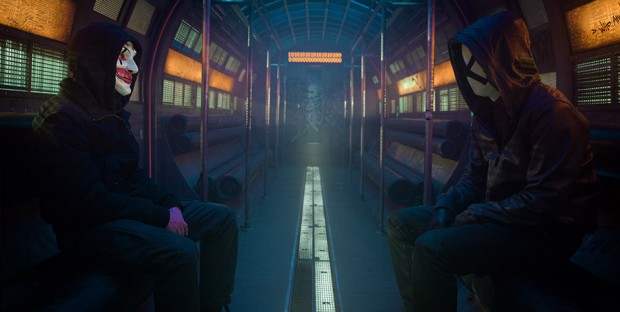In the pantheon of great films about technology, there are very few members exclusively devoted to coding, even fewer exclusively dealing with hacking. The main films that comes to mind when faced with these parameters are 1995’s Hackers, in which Matthew Lillard plays a skateboarding Pippi Longstocking lookalike, and 2001’s Swordfish, a film which people remember for John Travolta’s goofy facial hair and two other reasons which earned Halle Berry about a million dollars. So when discussing hacking movies, we’re not in good cinematic company. Sadly, Who Am I – No System Is Safe, while a stronger film than many of its contemporaries, struggles to become anything more than just good.
The film begins, in the most noirish way possible, with its climax. Benjamin (Tom Schilling), a self described nobody with dreams of grandeur and a tragic backstory, enters a bloodspattered room as his narration relays the tale of his descent. Benjamin, a computer prodigy, is introduced to the charismatic Max (Elyas M’Barek), a wannabe revolutionary with some kind of bipolarity. Max and Benjamin team up with their contemporaries to form a hacker collective, CLAY. What starts off as harmless pranks directed towards fascists and banks, slowly becomes more and more dangerous as the group draws the attention of the Russian mafia, Europol and rival hackers.
What needs to said about the film is that it is a terribly stylish endeavor. When you’re trying to convey the intricacies and excitement to be derived from hacking, you’re ultimately kind of limited. Hackers, to its credit, did come up with a visually intriguing way to convey this conflict, albeit in the most ridiculous way possible. The film comes up with a number of neat solutions to this problem. For example, when showing interactions in a dark net chat room, the film uses this disused, graffitied subway car. It looks like the kind of place where unspeakable actions have occurred. All the members in the chat room wear masks to hide their identity, while also modulating their voices. It’s a clever way of giving the audience an in into this world without resorting to characters expositing that they are in the dark net or that they are speaking to a certain person. In the real world too, the film exercises a great deal of visual flair. Director Baran Bo Odar and DoP Nikolaus Summerer are very clearly visualists first and foremost and they inject the film with some adventurous and ingenious photographic tricks. The film uses whip pans and extreme closeups to create a kind of manic energy which adds a decent pulse to the proceedings. It brings to mind the likes of Darren Aronofsky or Edgar Wright, albeit with less of the emotional and spiritual heft of their bodies of work.
The main flaw with the film is how fluffy it is. At first the film seems to be making a sincere point about inadequacy and how these feelings drive us to do terrible and wonderful things. A lot of this idea is filtered through the superhero ideology in a rather compelling manner. However as the film progresses, it becomes more and more of a bog standard technological thriller. There is copious amounts of technobabble, club sequences with pulsating techno music and double, triple and quadruple crosses. As it moves towards its ending, the film has less and less to say outside of its visual palette and at 105 minutes it could stand to lose to more than a few minutes of its runtime. This is particularly true for its climax, which, while admittedly quite clever, feels less like a genuine welcome surprise adding a little kick to the end of the film and more like a cheap trick that undermines other decisions the film has just made. You can see how and why the film progresses in that way, but a part of you kind of wishes it didn’t take the path it decided upon.
It’s a decent bit of fluff with some very nice visual trickery and some ADD riddled energy, you just wish it could have been that little bit more. Will Murphy






